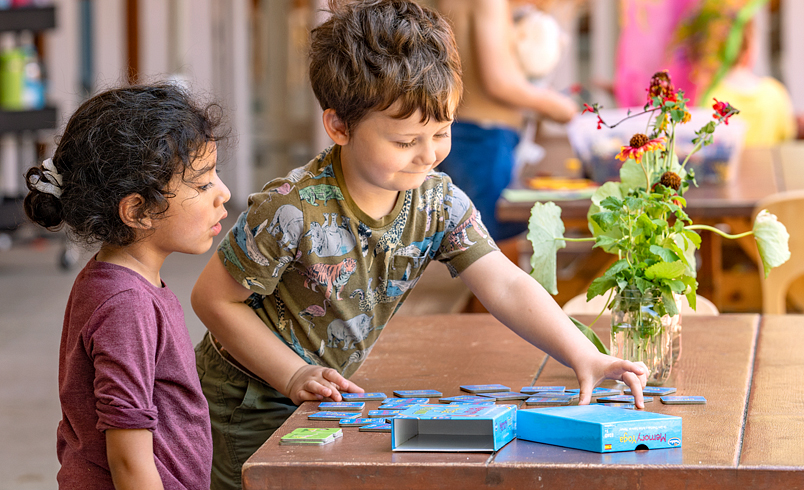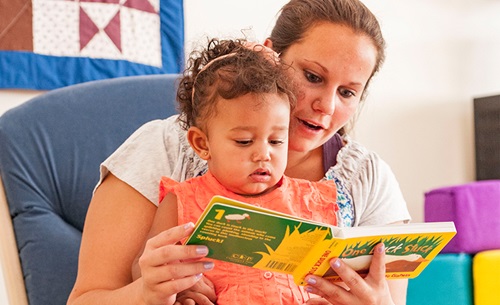Memory: The Heart of all Learning
The Importance of Enactive and Iconic Memory for Young Children
| August 2023Memory is at the heart of all learning. When a child returns from a visit to a farm, she can recall events by describing to her parents what she saw, drawing a picture of the pigs in their pigsty, or playing with the toy animal-set in her room. All these activities require memory—the ability to store information for later use. Specific academic learning also depends on memory. Johnny has learned that adding one block to another block makes two. Now his teacher wants to add another block to make three. But if Johnny has already forgotten the first lesson, this activity will be very difficult.
How Does Memory Work?
The information processing theory can help us understand the processes involved in remembering something (Berger 2003). This theory describes how we put information into our memory, store it, and then how we retrieve it when it is needed.
But this is where it gets interesting. When we talk about memory, most people think of symbolic memory. Symbolic memory requires two kinds of symbols: words and numbers. It is what we use as we find words to represent ideas, objects, or experiences. We use symbolic memory when we collect memories of similar objects, ideas, events, and experiences into categorical files. The information we store can then be used to solve problems, write stories,and learn about similar and different subjects. As we continue to experience and learn, we expand the information about the things we have learned.
Academic teaching and learning focuses on using symbolic memory. It’s accurate, flexible, and very functional. It enabled Shakespeare to write plays, Bertrand Russell to develop philosophies, and Einstein to create scientific formulas. And in early childhood programs and schools, most instructional approaches focus on the use of language and numbers, both to prepare children for formal schooling, and to help children regulate their behaviors, such as using words to express anger or frustrations. One can often hear a teacher in a preschool classroom saying, “use your words”.
Enactive and Iconic Memory
There are many forms of memory. People who sing or play an instrument know about musical memory, and of course songs are used a great deal in early childhood programs. The American psychologist, Jerome Bruner focused on enactive and iconic memory. Further, he argued that young children often find these forms of memory easier to use than words; and many young children choose to use them before they progress to the more complex and difficult symbolic memory (Bruner, 1960).
What are enactive and iconic memory?
Enactive memory is muscle memory. It’s the memory we use to repeat a dance step, kick a soccer ball, walk, run, and skip.
Children often point, move their arms, crunch down low, and skip to replicate something they have seen or experienced. The other day I was watching my six-year-old grandson, Gabriel, put together a complex array of train tracks on the floor of his room. He said nothing, but very intently looked at the tracks on the floor and then motioned with his arms to determine the direction and form he wanted the new tracks to take.
Iconic memory is our ability to use pictures, maps, diagrams, and designs as abstract representation. Many young children love to draw pictures of experiences they have had. Also, many teachers correctly use pictures to help young children begin to write. Arrows, smiley faces, and pictures in books for young children are all examples of iconic memory.
Children use enactive and iconic memory when they engage in play, especially physical play, as they repeat motor activities, imitate skills, and master new physical sequences. In constructive play, they use both types of memory for patterning, sequencing, constructing, copying, and imitating designs and structures (Johnson, Christie & Wardle, 2005). Readers familiar with Howard Gardner’s eight learning styles will recognize enactive memory as kinesthetic learning, iconic memory as spatial intelligence, and symbolic memory as linguistic and logical-mathematical intelligences (Gardner, 1983).
Thus, using enactive memory—muscle movement, physical direction, repetition, and gestures; and iconic memory—pictures, symbols, arrows; is a central part of young children’s cognitive learning. While some children naturally progress to almost total symbolic memory, others continue to rely on enactive and/or iconic memory into their adult lives—especially professional athletes, dancers, artists, designers, and architects.
Don’t Jumpstart Symbolic Memory
We too quickly focus on using symbolic memory (words and numbers) with young children. But experiences that build iconic and enactive memory lay essential groundwork for children’s cognitive development. For example, recent research has shown that young children can begin to determine quantity based purely on observing objects, without having to actually count each item (Lavoire 2008).
Using enactive and iconic memory with young children also encourages movement, something desperately needed throughout today’s early childhood programs (Jensen, 2015), and honors and supports children’s art activities, an important, necessary part of early childhood practice and a precursor to learning how to write (Dyson, 1990). Many young children find using enactive and iconic memory easier and more accessible than using words and numbers. This is particularly true of children whose language development may be delayed compared to other children (i.e. many boys), and young children learning a second language (Wardle, 2018).
Scaffolding Symbolic Memory
Activities that support enactive and iconic memory scaffold children’s use of symbolic memory. For example, many teachers encourage children to count as they climb up and down stairs. One of my college students taught her elementary students the multiplication tables using skip rope routines. The game of hop-scotch also teaches numbers. Singing games, and other movement/verbal activities help children develop enactive and iconic alongside symbolic memory. Teachers use iconic memory in the classroom as they reference visual labels, instructions, and schedules. They also use picture books to teach specific words and encourage children to talk about experiences that the pictures trigger. Teachers may ask their students, “tell me about your picture”.
Developing the use of words and numbers should come after the child has mastered the ability to use physical movement and gestures, pictures and drawings to recall past experiences, and to manipulate ideas in their mind.
Conclusion
Memory is at the heart of all learning. While we focus on symbolic memory in early childhood programs and schools, many young children thrive on using enactive and iconic memory. Thus, it is very important to develop, encourage and support young children’s use of enactive and iconic memory, not rushing them too quickly in focusing on symbolic memory. This is particularly true for children who struggle with language development, and /or who are learning a second language. Once a child has developed enactive and iconic memory, they can be taught to use symbolic memory by scaffolding learning around these existing behaviors. While some children naturally progress toward using symbolic memory in school and life, others will always prefer to use enactive or iconic memory in certain settings.
References
Berger, S. K. (2003). Information processing. In, The Developing Person. Though Childhood and Adolescence. New York: Worth Publishers.
Burner, J. (1960). The Process of Education. Cambridge, MA.
Dyson, A. (1990). Symbol makers, symbol weavers: How children link play, pictures and print. Young Children, 45(2), 50-57.
Gardner, H. (1983). Frames of Mind: The Theory of Multiple Intelligences. New York: Basic Books.
Jensen, E. (2015). Teaching with the Brain in Mind (2nd ed.). Alexandra, VA: ASCD.
Johnson, J. E., Christie, J. F. & Wardle, F. (2005). Play, Development, and Early Education. Boston, MA: Allyn & Bacon.
Lavoire, A. (2008). Infants are able to recognize quantity. The Harvard Gazette. https://news.harvard.edu/gazette/story/2008/02/infants-are-able-to-recognize-quantity/
Wardle, F. (2018). Oh Boy. Strategies for Teaching Boys in Early Childhood. Lincoln, NE: Exchange Press










